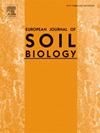干旱和凋落物质量对地中海森林土壤动物分解贡献的影响
IF 3.3
2区 农林科学
Q1 ECOLOGY
引用次数: 0
摘要
土壤动物加速凋落叶分解和养分动员;然而,干旱和凋落物质量对这些关键生态系统过程贡献的综合影响仍未得到充分探讨。研究了干旱和凋落物质量对地中海森林土壤动物群落凋落叶分解的影响。在8个150-m2的地块上,用不同网目大小的凋落物袋孵育栎树和白杨凋落叶1年;一半接受长期干旱治疗。我们测量了每个凋落物袋的凋落物生物量损失、凋落叶、叶片和凋落叶中的氮浓度以及每个地块的光合有效辐射。在垃圾袋孵育期间,对土壤中系动物进行了三次取样。结果表明,干旱条件下,林分凋落物质量损失较大,而干旱条件下,林分凋落物质量损失不显著。尽管土壤动物对凋落物分解的总体贡献在干旱条件下略低,但在两种处理下,土壤动物总体上更喜欢阔叶林而不是冬青。在冠层高度降低的干旱样地,光消率较低,表明木质素和纤维素可能受到太阳辐射的降解。阔叶林凋落物氮含量高于冬青,这可能是由于阔叶林的吸收效率较低,这可能是土壤动物对阔叶林的偏好。干旱显著影响了土壤中游动物的丰度,使其密度减少了37.9%。我们的研究表明,干旱对土壤动物群落的直接影响可能会限制它们促进凋落物分解的能力,阻碍它们在持续气候变化的地中海生态系统中抵消养分循环减缓的能力。本文章由计算机程序翻译,如有差异,请以英文原文为准。
Drought and litter quality effects on the contribution of soil fauna to decomposition in a Mediterranean forest
Soil animals accelerate leaf litter decomposition and nutrient mobilization; however, the combined effects of drought and litter quality on their contributions to these key ecosystem processes remain underexplored. We investigated the effects of experimental drought and litter quality on soil fauna communities’ contributions to leaf litter decomposition in a Mediterranean forest. Leaf litter from Quercus ilex and Phillyrea latifolia, was incubated for one year in litterbags with varying mesh sizes across eight 150-m2 plots; half received long-term drought treatment. We measured litter biomass loss in each litterbag, leaf litterfall, nitrogen concentrations in leaves and litter, photosynthetically active radiation at each plot. Soil mesofauna were sampled three times during litterbag incubation. Our results showed that litter mass loss was greater for P. latifolia under experimental drought, while no significant differences were found in controlled conditions. Soil animals generally preferred P. latifolia over Q. ilex in both treatments, although overall contribution to litter decomposition was slightly lower under drought. Light extinction rate was lower in drought plots with reduced canopy height, indicating potential degradation of lignin and cellulose by solar radiation. Litter of P. latifolia contained higher nitrogen concentrations than Q. ilex, attributed to its lower resorption efficiency, possibly explaining its preference by soil fauna detritivores. Drought significantly impacted soil mesofauna abundance, reducing their density by 37.9 %. Our research indicates that direct impacts of drought on soil fauna communities might constrain their ability to facilitate litter decomposition, hindering their capacity to counteract nutrient cycling slowdown in Mediterranean ecosystems amid ongoing climate change.
求助全文
通过发布文献求助,成功后即可免费获取论文全文。
去求助
来源期刊

European Journal of Soil Biology
环境科学-生态学
CiteScore
6.90
自引率
0.00%
发文量
51
审稿时长
27 days
期刊介绍:
The European Journal of Soil Biology covers all aspects of soil biology which deal with microbial and faunal ecology and activity in soils, as well as natural ecosystems or biomes connected to ecological interests: biodiversity, biological conservation, adaptation, impact of global changes on soil biodiversity and ecosystem functioning and effects and fate of pollutants as influenced by soil organisms. Different levels in ecosystem structure are taken into account: individuals, populations, communities and ecosystems themselves. At each level, different disciplinary approaches are welcomed: molecular biology, genetics, ecophysiology, ecology, biogeography and landscape ecology.
 求助内容:
求助内容: 应助结果提醒方式:
应助结果提醒方式:


